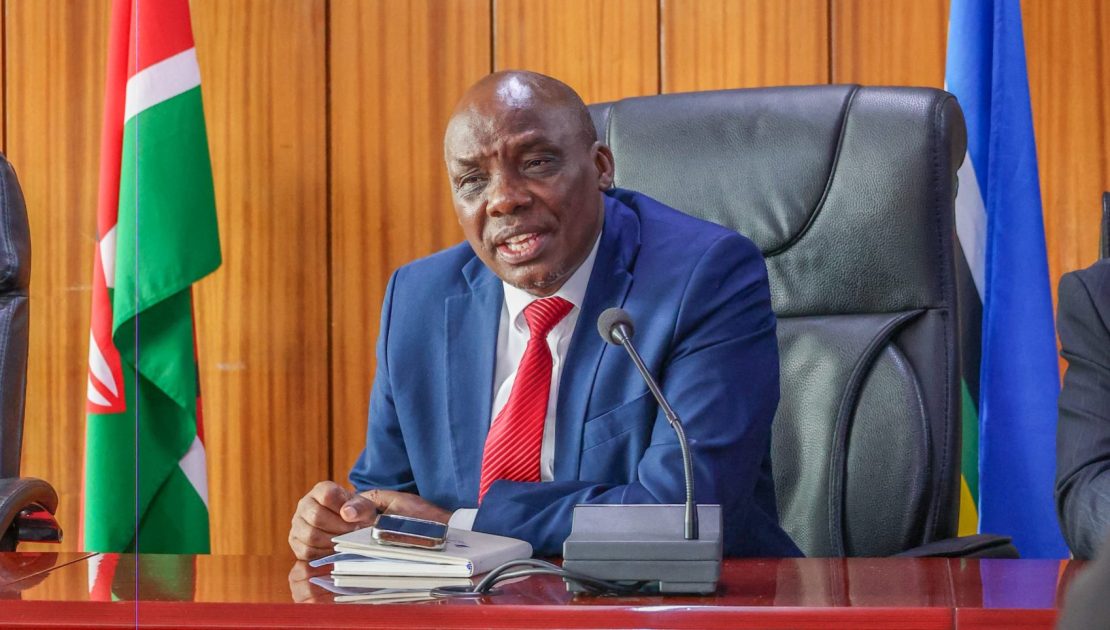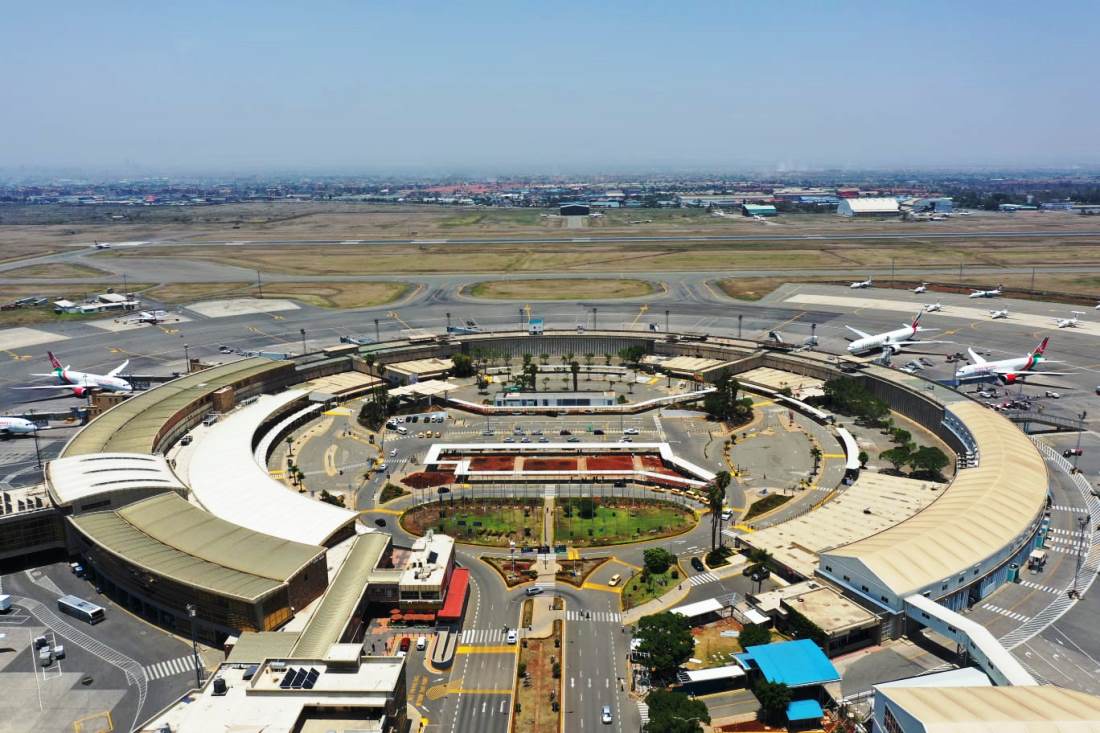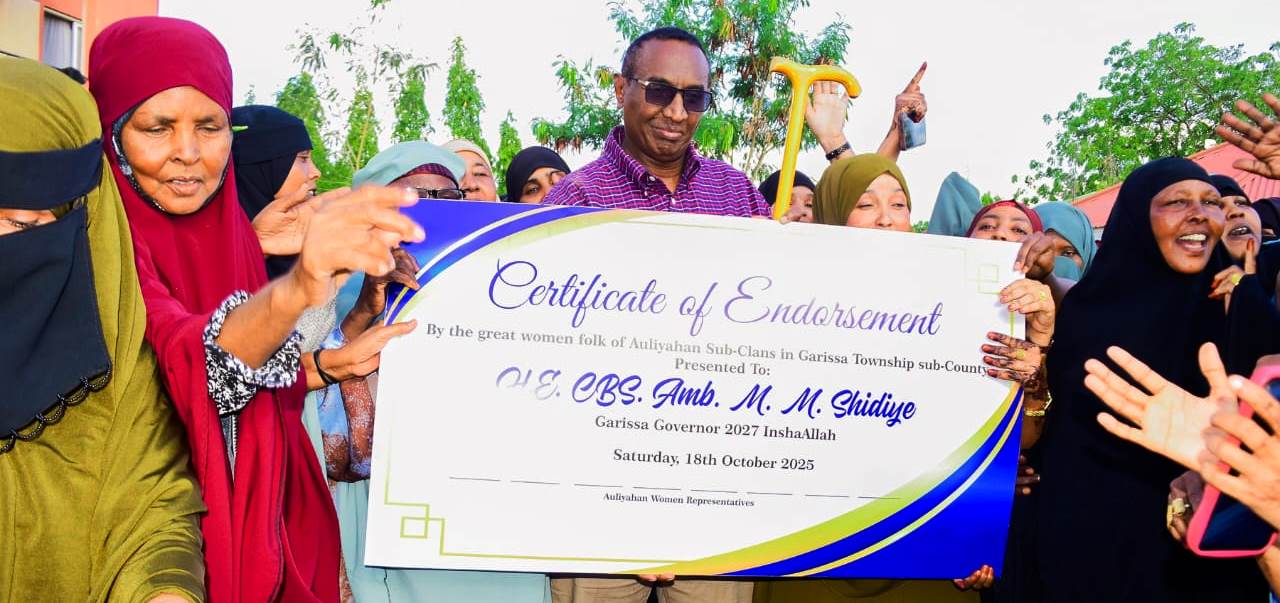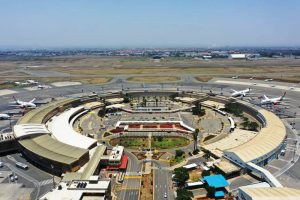Aerial view of JKIA that is earmarked for construction of a new runway and world class passenger terminal by 2029. PHOTO/GDU.
By SPECIAL CORRESPONDENT
The Government Delivery Unit (GDU) has intensified its oversight of the ongoing modernisation of Kenya’s airports and airstrips, marking a significant step towards strengthening regional connectivity and positioning the country as a leading aviation hub in Africa.
This latest push is part of Kenya’s broader strategy to enhance its aviation infrastructure, promote economic growth, and improve trade and tourism links across the continent.
On Friday, Mr. Olando Sitati, the Acting Head of the GDU, led a high-level meeting with senior officials from the Kenya Airports Authority (KAA).
The gathering, which was held in Nairobi, brought together key figures from KAA, including the Acting Managing Director, Mr. Abraham Kiprutto, and the General Manager for Projects and Engineering, Eng. Meshack Ochieng.
The purpose of the meeting was to review the progress of critical airport and airstrip development projects currently underway across the country.
These projects form a core part of the National Government’s commitment to modernising air transport infrastructure, a key promise under President William Ruto’s transformative agenda.
This initiative is closely aligned with Kenya’s Vision 2030, which aims to elevate the nation to middle-income status by 2030, and the Bottom-Up Economic Transformation Agenda (BETA), designed to drive inclusive economic growth by targeting investments in various sectors across the country.
Speaking at the meeting, Mr. Sitati reiterated the government’s resolve to modernise and expand Kenya’s aviation infrastructure, underscoring its importance in driving economic development.

Acting Head of GDU, Mr. Olando Sitati (Brown suit) together with Kenya Airport Authority’s (KAA) General Manager in charge of Marketing and Business Development (maroon jacket) and Engineer Meshack Ochieng General Manager (Projects & Engineering), KAA together with GDU team after successful deliberations on implementation status and action plans for priority airports and airstrips across the country. The meeting was held at the KAA head office. PHOTO/GDU.
“Modern, efficient airports are fundamental to positioning Kenya as a first-class economy by 2050,” he stated. “The upgrades we are undertaking will not only improve air transport connectivity but also enhance the overall passenger experience, bolster cargo handling, and attract investment. These are critical elements in achieving our long-term economic vision.”
Among the most ambitious projects being undertaken at Jomo Kenyatta International Airport (JKIA) is the installation of state-of-the-art passenger boarding bridges and ground-handling equipment, scheduled for completion by June 2026.
This project is part of a broader series of improvements aimed at enhancing the airport’s capacity to handle both passengers and cargo more efficiently.
By June 2027, JKIA will also see the construction of a new runway, which will be followed by the development of a world-class passenger terminal by 2029.
These upgrades will position JKIA as a key regional aviation hub and significantly improve Kenya’s competitiveness within the African aviation sector.
In addition to the major developments at JKIA, the GDU and KAA teams assessed ongoing and planned works at various regional airstrips across the country.
These include airstrips in Kabunde, Lichota, Suneka, Malindi, Ukunda, Voi, Ikanga, Lokichoggio, Narok, Kilgoris, Bomet, Kerenga, Lanet, Garissa, Mandera, Elwak, Itugururu, Mitunguu, Nanyuki, Kakamega, Matulo, Busia, and Ithookwe.

Aerial view of the 950 meters runway of Ithookwe/Kitui Airstrip that is part of the aviation infrastructure meant to open up regions and connectivity. PHOTO/GDU.
The expansion and upgrading of these regional airports are central to the government’s plans to decentralise air transport services, making them more accessible to communities in the remote and underserved areas of Kenya.
A key part of this initiative is the extension of the Eldoret International Airport runway, which is set to be lengthened to 3.5 kilometres. This upgrade will enable the airport to accommodate larger aircraft, improving its capacity to handle both international and domestic flights.
Other important upgrades include the widening of the Kisumu International Airport runway, the rehabilitation of the airside grounds at Moi International Airport in Mombasa, and the expansion of the runway at Malindi International Airport to a length of 2.5 kilometres.
Additionally, the Kenya Airports Authority has identified a new site for the proposed Busia Airstrip, which will help connect the western region of Kenya to the broader East African region.
Plans are also underway to upgrade several other airstrips, including those in Boma, Elwak, Aldas, Kanyonyo, and Nyaribo, which will further enhance accessibility and connectivity in these regions.
The GDU has emphasised that these ambitious investments in aviation infrastructure are not just about improving air travel but are also expected to stimulate economic growth across the country.
The upgrades will create thousands of jobs, attract international investors, and facilitate the decentralisation of aviation training, thereby contributing to the development of a highly skilled workforce in the sector.

Mr. Patrick Amimo ( in red tie) and Engineer Khamisi Butichi from the Government Delivery Unit (GDU) with Mr. Abraham Kiprutto, General Manager in charge of Marketing & Business Development, KAA, in a meeting to assess implementation status of priority airports and airstrips across the country. PHOTO/GDU.
Moreover, by improving regional connectivity, these investments will open up new markets for trade and tourism, ultimately helping to achieve Kenya’s vision of becoming a middle-income, first-class economy by 2050.
“These high-impact investments will not only connect regions and open up new economic opportunities but will also contribute to Kenya’s broader vision of sustainable and inclusive growth,” said Mr. Sitati. “Our aim is to ensure that every corner of the country benefits from enhanced air transport connectivity, creating a more integrated and competitive economy.”
In the long run, these modernisation efforts are expected to play a pivotal role in driving Kenya’s aspirations to become a global aviation powerhouse.
With a renewed focus on regional and international connectivity, Kenya is well on its way to becoming one of the leading aviation hubs in Africa, positioning itself as a key player in the global air transport industry.
The government’s push to modernise the nation’s airports and airstrips represents a forward-thinking strategy aimed at addressing the country’s infrastructure needs while simultaneously boosting trade, tourism, and job creation.
By prioritising efficient and modern air transport systems, Kenya is laying the groundwork for a future where economic growth is underpinned by seamless regional and international connectivity.


















